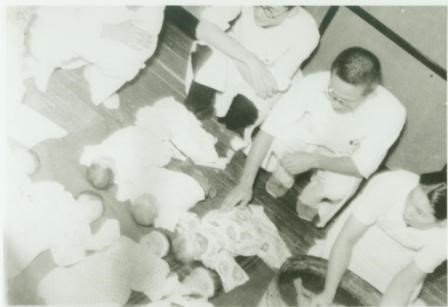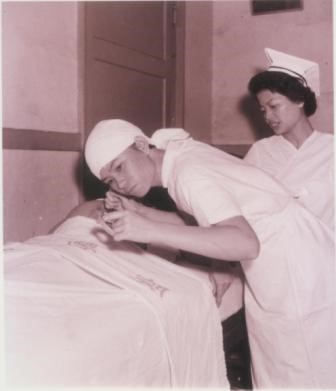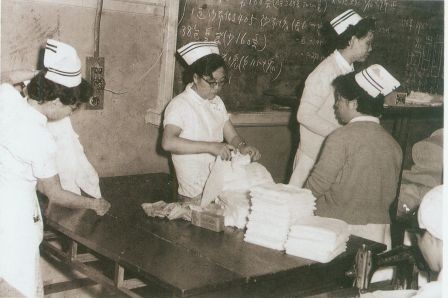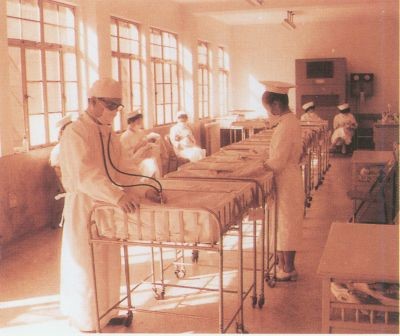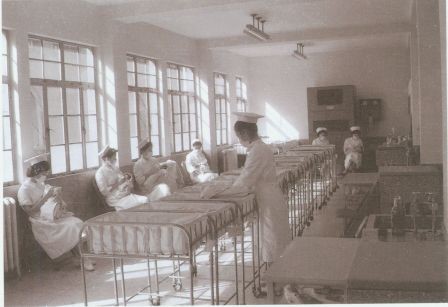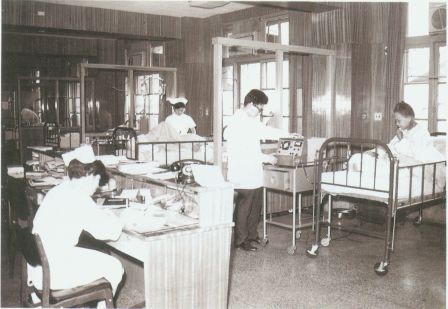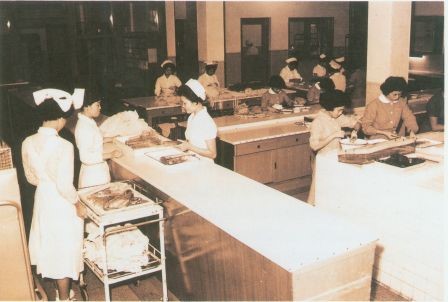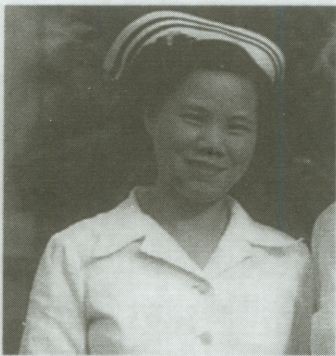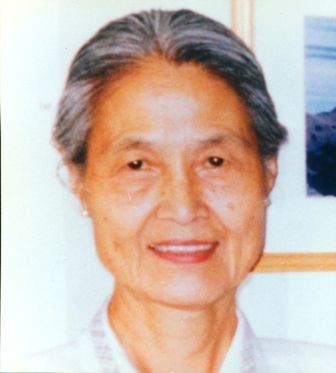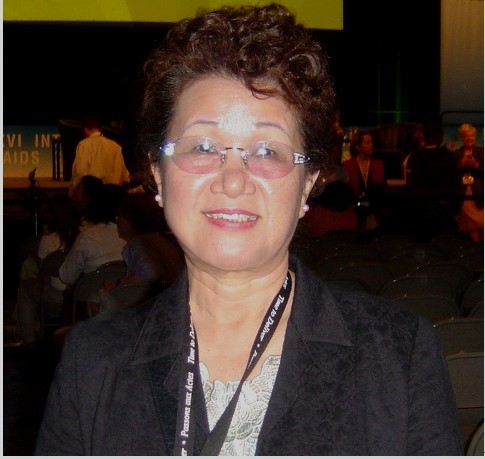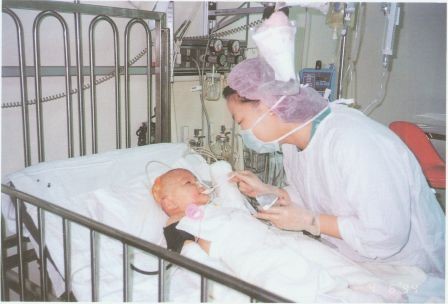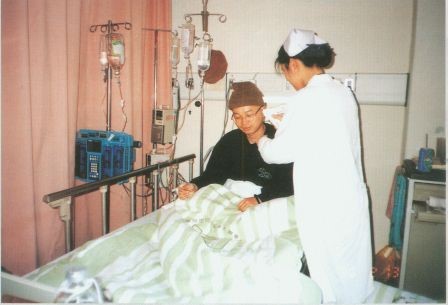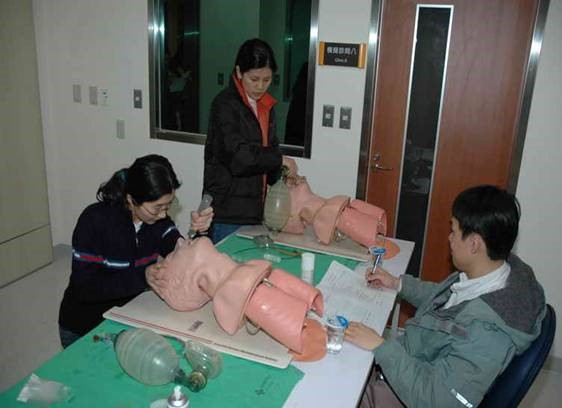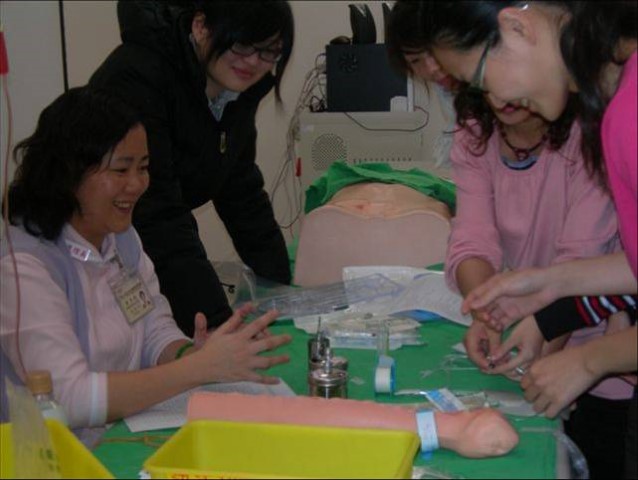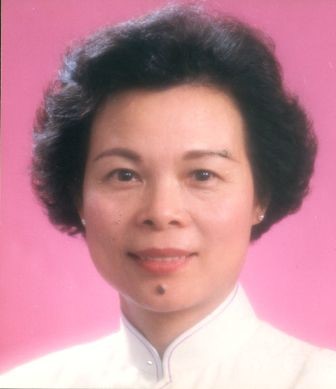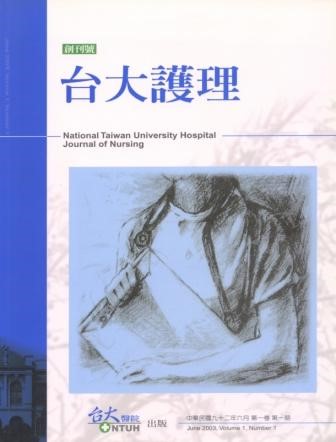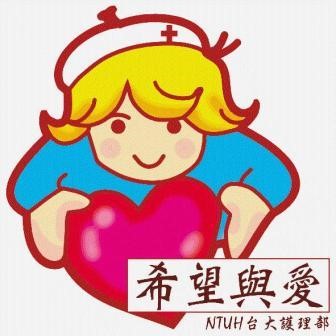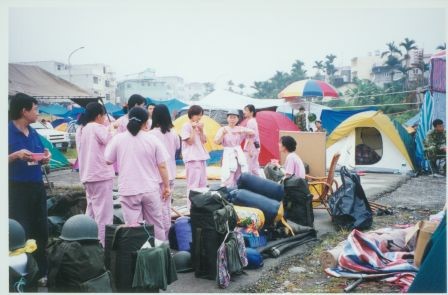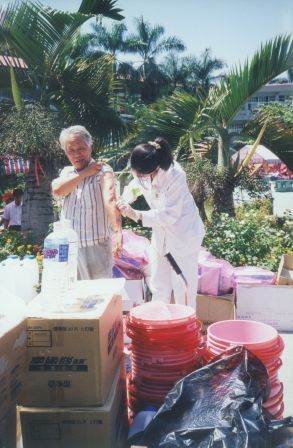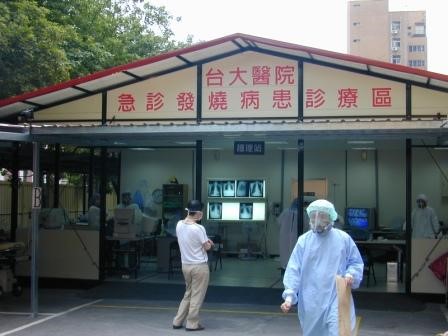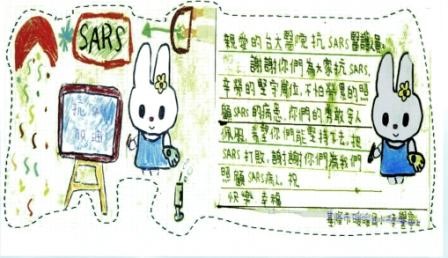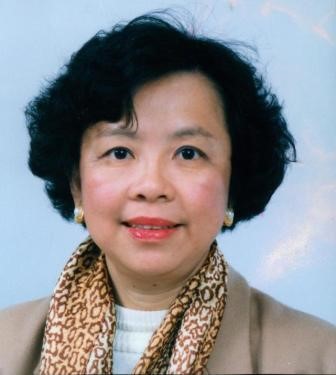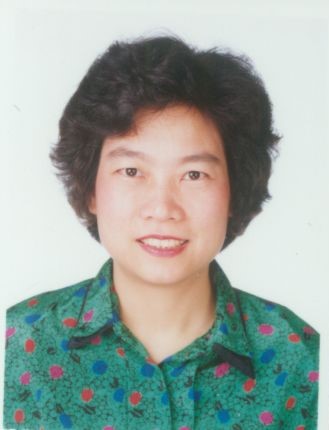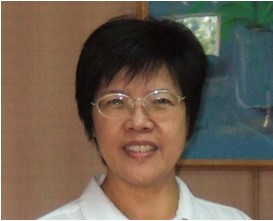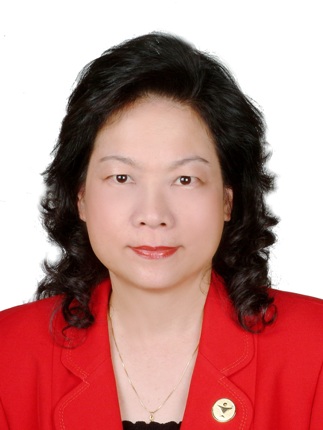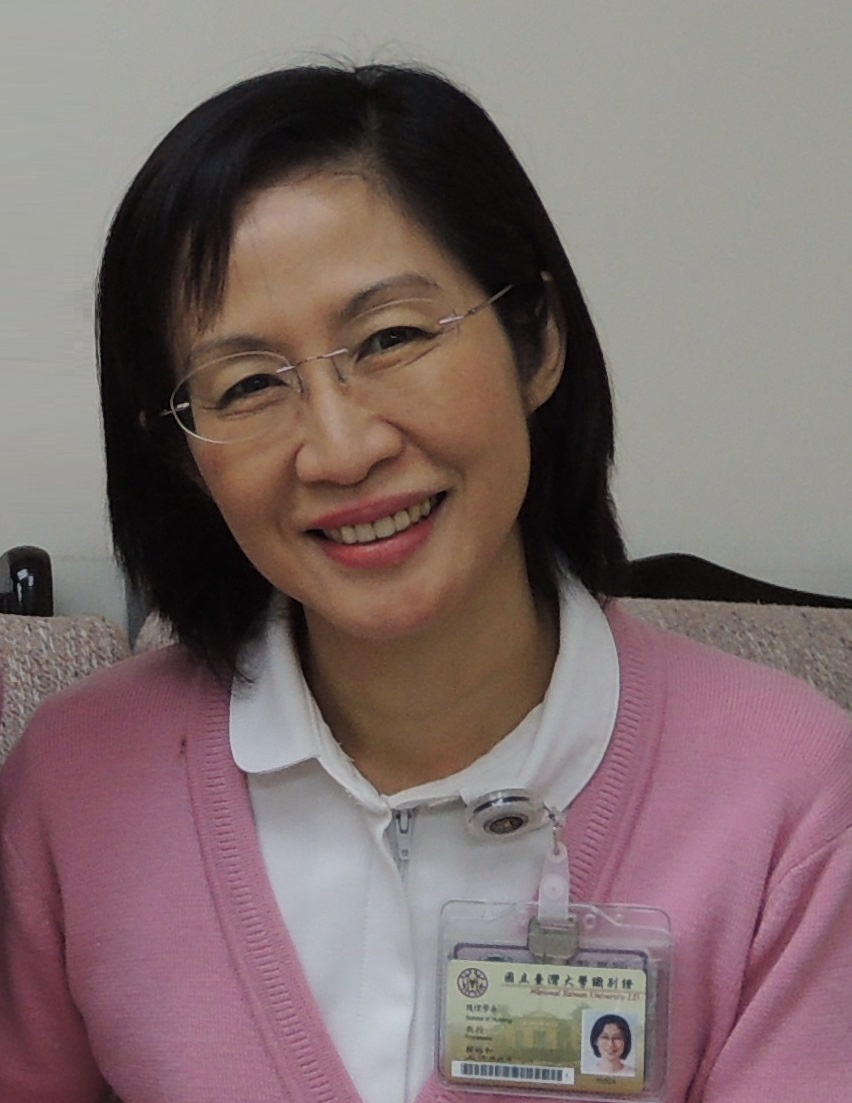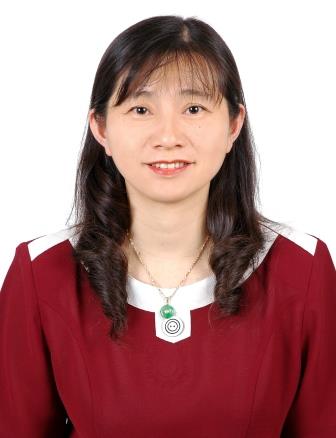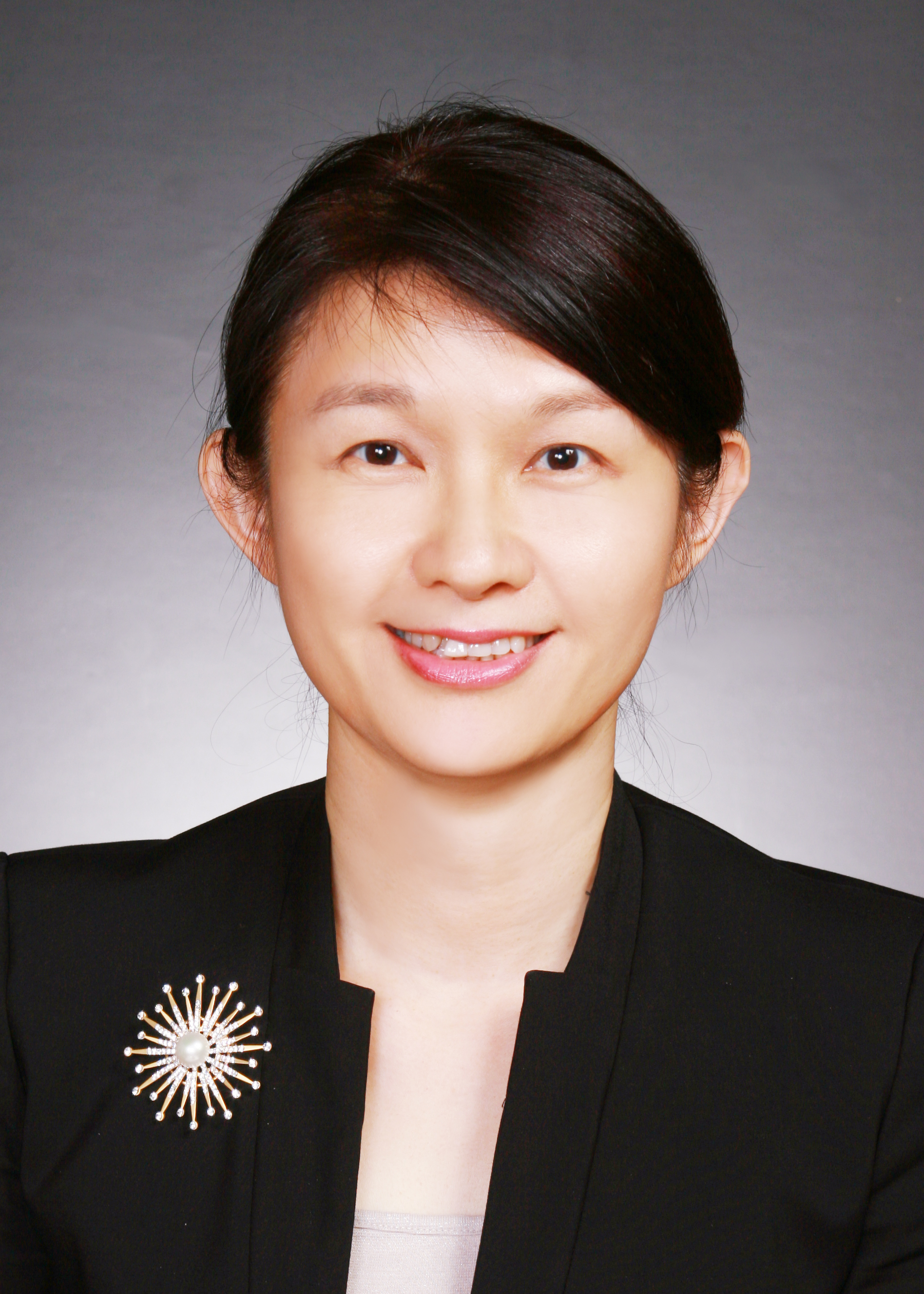In 1949, NTUH had a total of 518 beds and only about 60 nurses. During this stage, NTUH was faced with many challenges as there was the need to address a number of largely neglected matters without the means or organization to do so. Given this, a nursing department would be called upon to embark on a most difficult, unwieldy and previously unchartered course.
The Nursing Department of NTUH, with a nursing director, was formally established in August of 1949 and has a history of 66 years. During these years, there have been 11 nursing directors: Tsui-Yu Chen who held the position from August 1949 to February 1958; Hsi-Mei Ying from February 1958 to October 1972; Hsin-Hsin Chung from October 1972 to July 1978; Yu-Mei Yu from August 1978 to July 1984; Chao-Feng Chow from August 1984 to July 1992; Yueh-Chih Chen from August 1992 to July 1996; Shu-Jen Shiau from August 1996 to July 1999; Lian-Hua Huang from August 1999 to January 2005, and Yu-Tzu Dai from February 2005 to July 2009, and Lian-Hua Huang from August 2009 to July 2015, Yeur-Hur Lai from August 2015 to July 2017, Wen-Yu Hu from August 2017 to July 2023 and Chia-Hui Chen from August 2023 to present. The nursing development and achievements of the eleven nursing directors can be divided into these 3 stages: "Initial nursing profession period", "Nursing concept transition period", and "Nursing profession promotion period".
|
1930-1940, Japan Red Cross Taiwan Branch Hospital Baby Room
|
1950, Delivery Room
|
||||||||||||||||||||||||||||||||||||||||||||||||||||||||||||||||||||||||||||||||||||||||||||||||||||||||||||||||||||||||||||||||||||||||||||||||||||||||||||||||||||||||||||||||||||||||||||||||||||||||||||||||||||||||||||||||||||||||||||||||||||||||||||||||||||||||||||||||||||||||||||||||||||||||||||||||||||||||||||||||||||||||||||||||||||||||||||||||||||||||||||||||||||||||||||||||||||||||||||||||||||||||||||||||||||||||||||||||||||||||||||||||||||||||||||||||||||||||||||||||||||||||||||||||||||||||||||||||||||||||||||||||||||||||||||||||||||||||||||||||||||||||||||||||||||||||||||||||||||||||||||||||||||||||||||||||||||||||||||||||||||||||||||||||||||||||||||||||||||||||||||||||||||||||||||||||||||||||||||||||||||||||||||||||||||||||||||||||||||||||||||||||||||||||||||||||||||||||||||||||||||||||||||||||||||||||||||||||||||||||||||||||||||||||||||||||||||||||||||||||||||||||||||||||||||||||||||||||||||||||||||||||||||||||||||||||||||||||||||||||||||||||||||||||||||||||||||||||||||||
Initial Nursing Profession Period
During this initial stage the major development of nursing included the establishment of a nursing system, definition and arrangement of work associated with nursing, education of nursing staffs and the development and improvement of equipment used in the environment. This whole scheme was mainly under the leadership of the 1st director, Tsui-Yu Chen, and the 2nd director, Hsi-Mei Ying.
Establishment of the nursing system
During the period of the Japanese occupation of Taiwan, the nursing system was modeled on the German-Japanese pattern. Director Tsui-Yu Chen, changed the nursing system by modeling it on the British-American pattern. Director Chen brought about a transformation in the work shifts in nursing. In the beginning there were only two work shifts where nurses covered the shift during the day but at night nurses were “on call”. In the British-American pattern, though, there were three nursing work shifts making it possible for the patients to receive 24-hour nursing care.
Director Tsui-Yu Chen also instituted a transformation in the employment of nursing staffs. In the beginning the general affairs office was responsible for the employment of nurses and administrators. After changes were enacted the nursing department took over the responsibility of the employment of nurses. The nursing department began to manage the assignment of nursing work and the arrangement of the working units. Also, it was during this period that nurses were allowed to continue working after marriage. In regard to nursing management, Director Tsui-Yu Chen devised the ‘Performance Appraisal Methods of Nursing’, and ‘Practice Rules for Students in Nursing Schools’. Also, in 1953, she established ‘The Employment Method for New Nurses’ which stipulated that new nurses must complete an examination on paper, an oral examination and a period of 3 months’ probation before they would be accepted for regular employment. During the period of Director Hsi-Mei Ying, the method of employment for new nurses became even more complete. From 1960, the graduates of the Nursing School of NTU had priority when it came to procuring employment. Starting in 1965, public nursing schools recommended outstanding nursing graduates for employment. This system, still in existence, continues to play a major role in the foundation of the nursing system and in management for the future.
|
1950, General Ward
|
1961, Baby Room
|
||||||||||||||||||||||||||||||||||||||||||||||||||||||||||||||||||||||||||||||||||||||||||||||||||||||||||||||||||||||||||||||||||||||||||||||||||||||||||||||||||||||||||||||||||||||||||||||||||||||||||||||||||||||||||||||||||||||||||||||||||||||||||||||||||||||||||||||||||||||||||||||||||||||||||||||||||||||||||||||||||||||||||||||||||||||||||||||||||||||||||||||||||||||||||||||||||||||||||||||||||||||||||||||||||||||||||||||||||||||||||||||||||||||||||||||||||||||||||||||||||||||||||||||||||||||||||||||||||||||||||||||||||||||||||||||||||||||||||||||||||||||||||||||||||||||||||||||||||||||||||||||||||||||||||||||||||||||||||||||||||||||||||||||||||||||||||||||||||||||||||||||||||||||||||||||||||||||||||||||||||||||||||||||||||||||||||||||||||||||||||||||||||||||||||||||||||||||||||||||||||||||||||||||||||||||||||||||||||||||||||||||||||||||||||||||||||||||||||||||||||||||||||||||||||||||||||||||||||||||||||||||||||||||||||||||||||||||||||||||||||||||||||||||||||||||||||||||||||||||
|
1962, Baby Room
|
\ 1968, Medical ICU
|
||||||||||||||||||||||||||||||||||||||||||||||||||||||||||||||||||||||||||||||||||||||||||||||||||||||||||||||||||||||||||||||||||||||||||||||||||||||||||||||||||||||||||||||||||||||||||||||||||||||||||||||||||||||||||||||||||||||||||||||||||||||||||||||||||||||||||||||||||||||||||||||||||||||||||||||||||||||||||||||||||||||||||||||||||||||||||||||||||||||||||||||||||||||||||||||||||||||||||||||||||||||||||||||||||||||||||||||||||||||||||||||||||||||||||||||||||||||||||||||||||||||||||||||||||||||||||||||||||||||||||||||||||||||||||||||||||||||||||||||||||||||||||||||||||||||||||||||||||||||||||||||||||||||||||||||||||||||||||||||||||||||||||||||||||||||||||||||||||||||||||||||||||||||||||||||||||||||||||||||||||||||||||||||||||||||||||||||||||||||||||||||||||||||||||||||||||||||||||||||||||||||||||||||||||||||||||||||||||||||||||||||||||||||||||||||||||||||||||||||||||||||||||||||||||||||||||||||||||||||||||||||||||||||||||||||||||||||||||||||||||||||||||||||||||||||||||||||||||||||
In regard to the work associated with nursing and the initial arrangement of nursing work, Director Tsui-Yu Chen felt that the pattern of the Japanese management system was mainly functional nursing. The work given to nursing was disorderly and confusing and involved a great deal of non-professional nursing work such as accounting, and the preparation, disinfection and packaging of articles. Changes were made in order to enable nurses to have more energy and time to be involved in direct nursing care. Beginning in August 1950, 12 clerks were employed to deal with registration, consultation, borrowing x-ray charts, administration affairs and so on. This system has not only continued up to the present moment but many other hospitals also make use of this method. Improving the efficiency of nursing work in order for the patient to receive better nursing care, Director Tsui-Yu Chen combined the separate surgery rooms into one. The obstetric ward, delivery room, and baby room were also established. Before these changes, the postpartum mothers and the infants stayed in the general ward with the other patients. There was also a public health room where patients in the OPD and discharged patients could receive better nursing care. In 1974, the public health room was no longer necessary because the OPD, wards and the Chung-Shan Public Health Clinic carried on this work. Also noteworthy was the fact that Director Tsui-Yu Chen established a supply room as a means of reducing the non-professional work done by the nurses involving disinfecting and packaging supplies. Having a supply room decreased the waste of hospital equipment and it was able to supply the entire hospital with aseptic gauze and syringes, etc. Therefore, this was the forerunner of the central supply room in our hospital. We admire and respect Director Tsui-Yu Chen, for her penetrating insight and for the great courage she demonstrated in completing these difficult tasks.
|
1951, The previous Central Supplies Room
|
1963, The previous Central Supplies Room
|
||||||||||||||||||||||||||||||||||||||||||||||||||||||||||||||||||||||||||||||||||||||||||||||||||||||||||||||||||||||||||||||||||||||||||||||||||||||||||||||||||||||||||||||||||||||||||||||||||||||||||||||||||||||||||||||||||||||||||||||||||||||||||||||||||||||||||||||||||||||||||||||||||||||||||||||||||||||||||||||||||||||||||||||||||||||||||||||||||||||||||||||||||||||||||||||||||||||||||||||||||||||||||||||||||||||||||||||||||||||||||||||||||||||||||||||||||||||||||||||||||||||||||||||||||||||||||||||||||||||||||||||||||||||||||||||||||||||||||||||||||||||||||||||||||||||||||||||||||||||||||||||||||||||||||||||||||||||||||||||||||||||||||||||||||||||||||||||||||||||||||||||||||||||||||||||||||||||||||||||||||||||||||||||||||||||||||||||||||||||||||||||||||||||||||||||||||||||||||||||||||||||||||||||||||||||||||||||||||||||||||||||||||||||||||||||||||||||||||||||||||||||||||||||||||||||||||||||||||||||||||||||||||||||||||||||||||||||||||||||||||||||||||||||||||||||||||||||||||||||
Education of the nursing staff
In 1950, Director Tsui-Yu Chen worked to establish the Vocational Nursing School of NTUH, which was the junior nursing college of NTUH that was supported by President Sy-Nian Fuh for 8 years. In 1951, WHO sent 5 nursing experts to Taiwan to assist in the junior nursing college of NTUH, the nursing education of the hospital and education in nursing administration and nursing management. In 1956, the Nursing School of National Taiwan University was established and the Vocational Nursing School of NTUH stopped enrolling students.
Environment and Equipment improvement
During World War II, part of the hospital building was destroyed. After this, lacking a proper place, patients and family members often cooked in the hospital corridors but this soon became unpleasant and unhygienic. Therefore, Director Tsui-Yu Chen, assisted in the establishment of a nutrition department and the head nurses, in the initial stages, helped with its management. In the early days, the patients used mosquito nets but during the time of Director Hsi-Mei Ying, window screens were installed. Along with other medical equipment, syringes were changed and, by 1959, every ward had small high pressure sterilizers, etc. Even though it was very complicated to institute these improvements they had important effects on the entire hospital and the quality of nursing care provided. This initial period was arduous and it depended on the initiative and endeavor of Director Chen. The changes brought about were maintained by Director Ying and they served as important foundations for the nursing system and equipment management in NTUH.
|
1st director Tsui-Yu Chen
|
2nd director Hsi-Mei Ying
|
||||||||||||||||||||||||||||||||||||||||||||||||||||||||||||||||||||||||||||||||||||||||||||||||||||||||||||||||||||||||||||||||||||||||||||||||||||||||||||||||||||||||||||||||||||||||||||||||||||||||||||||||||||||||||||||||||||||||||||||||||||||||||||||||||||||||||||||||||||||||||||||||||||||||||||||||||||||||||||||||||||||||||||||||||||||||||||||||||||||||||||||||||||||||||||||||||||||||||||||||||||||||||||||||||||||||||||||||||||||||||||||||||||||||||||||||||||||||||||||||||||||||||||||||||||||||||||||||||||||||||||||||||||||||||||||||||||||||||||||||||||||||||||||||||||||||||||||||||||||||||||||||||||||||||||||||||||||||||||||||||||||||||||||||||||||||||||||||||||||||||||||||||||||||||||||||||||||||||||||||||||||||||||||||||||||||||||||||||||||||||||||||||||||||||||||||||||||||||||||||||||||||||||||||||||||||||||||||||||||||||||||||||||||||||||||||||||||||||||||||||||||||||||||||||||||||||||||||||||||||||||||||||||||||||||||||||||||||||||||||||||||||||||||||||||||||||||||||||||||
Nursing Concept Transition Period
From 1949 until the year 1960, our nursing predecessors were involved in laborious developments. When nursing in NTUH entered the year 1970, it had finally achieved effective regulation and the nursing process showed steady development. We had a total of 333 nurses (including 16 assistant nurses) and 3 midwives. Looking back over the development of nursing, this period shows marked improvement in nursing quality, the initial stage of the nurse specialist and the concept of scientific nursing management. This period was mainly under the leadership of the 3rd director, Hsin-Hsin Chung, and the 4th director, Yu-Mei Yu. Director Yu, the first nurse in Taiwan with a doctoral degree in nursing, introduced many new concepts.
Improvement of nursing quality
In 1973, Director Hsin-Hsin Chung, initiated the joint appointment for teachers of the nursing faculty making it possible for them to be involved in the nursing work of the hospital. This enabled them to integrate the school teaching and the clinical nursing standard as they introduced new clinical nursing knowledge. Also, under the leadership of Director Hsin-Hsin Chung, there was another important nursing revolution, namely, the original nursing model was changed from functional nursing (where one nurse would give injections to the patients while another would give patients their morning care) to that of a combination of both primary and team nursing. In the pattern that resulted, patients then had their nurses who were responsible for providing them with all the various components of nursing care. This brought about an improvement in the quality of nursing as patients were provided with individualized and comprehensive care. From that time on, the concept of primary nursing that was being developed in NTUH was the nursing model being used in the field of nursing nationwide. Director Yu-Mei Yu emphasized patient- centered nursing care and this concept is now the main trend in nursing throughout the world. Director Yu emphasized the concept of nursing quality control, she divided the organization of the nursing department into groups such as the in-service group and the quality control group etc. Also, in order to promote the quality of nursing management, she initiated a ‘Head Nurse Training Program’.
Initial stage of nursing specialist program
In 1975, with the support of the American Bureau for Medical Aid to China (ABMAC), Director Hsin-Hsin Chung, started 2 nursing specialist programs, namely, psychiatric and intensive care nursing. Under the leadership of Director Yu-Mei Yu, the development of the nursing specialist expanded. In 1980, as a means of promoting the medical quality by means of infection control, outstanding clinical nurses were selected be on the infection control team. They were responsible for the data collection of nosocomial infection, the surveillance of infection and the schema of concrete infection control. The infection control team still exists and continues to fulfill an essential function for the hospital. It has brought obvious improvement to the medical and nursing quality of the hospital.
Besides the emphasis put on patient-centered nursing during this period, the surgery building was just completed. Along with this came the need for a concept of management and a simplification of the process of nursing work by means of promoting the quality and capability of the central supply system. At this stage, the supply room began to provide the entire hospital with all types of sterilized packages. Even now the working process and method of the central supply system of NTUH are often used by other hospitals. Director Yu-Mei Yu also felt that the clinical nurses spent too much time dispensing medicine and suggested that there should be an improvement in the drug administration system. Under the scheme and coordination of Director Yu-Mei Yu and the pharmacy department, NTUH started with the unit dose distribution system (UDD) in 1984. This method not only saved time to use for direct nursing care it also decreased the waste of drugs and the rate of errors.
|
3th director Hsin-Hsin Chung
|
4th director Yu-Mei Yu
|
||||||||||||||||||||||||||||||||||||||||||||||||||||||||||||||||||||||||||||||||||||||||||||||||||||||||||||||||||||||||||||||||||||||||||||||||||||||||||||||||||||||||||||||||||||||||||||||||||||||||||||||||||||||||||||||||||||||||||||||||||||||||||||||||||||||||||||||||||||||||||||||||||||||||||||||||||||||||||||||||||||||||||||||||||||||||||||||||||||||||||||||||||||||||||||||||||||||||||||||||||||||||||||||||||||||||||||||||||||||||||||||||||||||||||||||||||||||||||||||||||||||||||||||||||||||||||||||||||||||||||||||||||||||||||||||||||||||||||||||||||||||||||||||||||||||||||||||||||||||||||||||||||||||||||||||||||||||||||||||||||||||||||||||||||||||||||||||||||||||||||||||||||||||||||||||||||||||||||||||||||||||||||||||||||||||||||||||||||||||||||||||||||||||||||||||||||||||||||||||||||||||||||||||||||||||||||||||||||||||||||||||||||||||||||||||||||||||||||||||||||||||||||||||||||||||||||||||||||||||||||||||||||||||||||||||||||||||||||||||||||||||||||||||||||||||||||||||||||||||
Nursing Profession Promotion Period
In the year 1980, the nursing department entered into the nursing profession promotion period. During this stage the major development included 5 aspects: the development of nursing specialty, the implementation of nursing quality control, the integration of teaching, research and service, the promotion of the professional nursing role, and the strengthening of the structure and function of the nursing department organization. From the year 1980, NTUH continued to expand and the number of nurses increased. In 1949, there were 518 ward beds and the allocation of 60 nurses. In 1984, there were 1,131 ward beds and the allocation of 545 nurses. In 2014, there were 2,332 ward beds and the allocation of 2,325 nurses. The nurse and ward beds ratios in 1949, 1984, and 2008 were 0.116, 0.481, and 0.997 respectively. The most important reasons for the increase in nursing manpower were the increase in ICU beds and the extension of the nursing role and function. It was in this period that NTUH confronted a great reformation-”The Moving of NTUH”. Under the leadership of Director Chao-Feng Chow, the 5th director, the nursing department participated in the schema of each department throughout the whole hospital. After moving, NTUH introduced advanced medical technology and equipment. The quality and quantity of nurses also rapidly expanded.
|
1994, Burn Unit
|
1996, General Ward
|
||||||||||||||||||||||||||||||||||||||||||||||||||||||||||||||||||||||||||||||||||||||||||||||||||||||||||||||||||||||||||||||||||||||||||||||||||||||||||||||||||||||||||||||||||||||||||||||||||||||||||||||||||||||||||||||||||||||||||||||||||||||||||||||||||||||||||||||||||||||||||||||||||||||||||||||||||||||||||||||||||||||||||||||||||||||||||||||||||||||||||||||||||||||||||||||||||||||||||||||||||||||||||||||||||||||||||||||||||||||||||||||||||||||||||||||||||||||||||||||||||||||||||||||||||||||||||||||||||||||||||||||||||||||||||||||||||||||||||||||||||||||||||||||||||||||||||||||||||||||||||||||||||||||||||||||||||||||||||||||||||||||||||||||||||||||||||||||||||||||||||||||||||||||||||||||||||||||||||||||||||||||||||||||||||||||||||||||||||||||||||||||||||||||||||||||||||||||||||||||||||||||||||||||||||||||||||||||||||||||||||||||||||||||||||||||||||||||||||||||||||||||||||||||||||||||||||||||||||||||||||||||||||||||||||||||||||||||||||||||||||||||||||||||||||||||||||||||||||||||
Development of the nursing specialist
The OPD nurses examination system started in 1985; the nutrition team in 1986; the organ transplantation team in 1987, the enterostoma endoscopic room (EER) in 1988; and the diabetic instruction team in 1990. Outstanding nurses were selected to be members of each team. Today, these teams not only perform the function of advanced practice nurses but also improve the quality of nursing care for the patients and are responsible for enhancing the professional knowledge of nurses.
During this period, nursing quality control had an obvious and innovative progression. For example, there was the integration and examination of nursing techniques, the investigation and improvement of patient satisfaction and the standardization and audit of the nursing record. In order to insure the standard of nursing quality, under the leadership of Director Chao-Feng Chow, the quality control nursing team started and completed the 1st edition of the book-’The Manual of NTUH Nursing Procedures’, which was the basis for the standard of nursing technique. The investigation of patient satisfaction started and teams for nursing assessment and the nursing record were established. Under the leadership of the 6th director, Yueh-Chih Chen, the accomplishment of nursing quality control was one of the most important responsibilities in the nursing department. From 1993 on, there has been one vice-director in the nursing department who is responsible for systemizing the management of nursing quality. Today, the investigation of patient satisfaction is done twice a year and this is an important basis for the improvement of nursing care. The surveillance of nursing work hours was also done during this stage and still serves as a basis for nursing manpower assignments that serve to decrease the phenomenon of uneven distribution. Also during this period there were assessments of crash cart equipment, of scenes where emergency help was summoned, of accident event reports, etc. All these serve to maintain and to provide better quality in emergent, critical and general nursing. Quality management standards for other nursing items are being established.
Along with the consideration of the nursing quality management of patient care, Director Yueh-Chih Chen also showed concern for the working environment of the clinical nurses by encouraging the use of the isolation room and by reducing the incidence of occupational injury in hospital personnel. Since 1992, in collaboration with Professor Jung-Der Wang from the safety health room, there have been investigations into clinical needle stick events and plans for the prevention and follow-up care of needle stick events.
Integration of teaching, research and service
According to the objectives of NTUH and beginning with Director Hsin-Hsin Chung, teachers from the nursing faculty gradually participated in joint appointment work in the hospital. Under the leadership of Director Yueh-Chih Chen, the joint appointment system for teachers of the nursing faculty and clinical nursing was emphasized. Besides this, 5 head nurses, supervisors, and vice-directors with a master or a higher degree are joint appointment lecturers in the NTUH School of Nursing. This system provides mutual benefits for both nursing teachers and clinical nurses. The clinical nurses have teaching experiences and combine teaching with clinical practice; whereas the teachers involved in clinical work help to bridge the gap between teaching and clinical practice and also introduce the newest nursing concepts into practical work. Besides providing in-service education for nurses, nurses are also encouraged to advance their studies both within the country and abroad. Since 1986, NTUH has sent nurses to France, South-Africa and the United States etc. to advance their studies. The nursing department encourages nurses to become involved in clinical research in order to improve the quality of clinical nursing.
|
CPR Training
|
Venipuncture Training
|
||||||||||||||||||||||||||||||||||||||||||||||||||||||||||||||||||||||||||||||||||||||||||||||||||||||||||||||||||||||||||||||||||||||||||||||||||||||||||||||||||||||||||||||||||||||||||||||||||||||||||||||||||||||||||||||||||||||||||||||||||||||||||||||||||||||||||||||||||||||||||||||||||||||||||||||||||||||||||||||||||||||||||||||||||||||||||||||||||||||||||||||||||||||||||||||||||||||||||||||||||||||||||||||||||||||||||||||||||||||||||||||||||||||||||||||||||||||||||||||||||||||||||||||||||||||||||||||||||||||||||||||||||||||||||||||||||||||||||||||||||||||||||||||||||||||||||||||||||||||||||||||||||||||||||||||||||||||||||||||||||||||||||||||||||||||||||||||||||||||||||||||||||||||||||||||||||||||||||||||||||||||||||||||||||||||||||||||||||||||||||||||||||||||||||||||||||||||||||||||||||||||||||||||||||||||||||||||||||||||||||||||||||||||||||||||||||||||||||||||||||||||||||||||||||||||||||||||||||||||||||||||||||||||||||||||||||||||||||||||||||||||||||||||||||||||||||||||||||||||
Reinforcement of the structure and function of the nursing department
Here it is best to compare NTUH 'before' and then 'after' moving to the new building in 1991. Before moving, the structure of the nursing department had 1 director, 1 vice-director, 5 supervisors and 46 head nurses. After moving; it was necessary to try to meet the challenges brought on by the rapid expansion and the progress of the nursing quality and quantity. In 1993, due to the endeavors of Superintendent Tong-Yuan Tai, the nursing department expanded to having 4 vice-directors with one each responsible for the management of budgeting and purchase, management of manpower, management of continued nursing quality and management of in-service education and research. The number of head nurses increased from 46 to 76 in 1994. The nursing department also strengthened the training program for head nurses by strictly and actively assisting them to participate in the leadership profession. The nursing department believes that such outstanding leaders are the change agents for a meaningful and prosperous future.
|
5th director Chao-Feng Chow
|
6th director Yueh-Chih Chen
|
||||||||||||||||||||||||||||||||||||||||||||||||||||||||||||||||||||||||||||||||||||||||||||||||||||||||||||||||||||||||||||||||||||||||||||||||||||||||||||||||||||||||||||||||||||||||||||||||||||||||||||||||||||||||||||||||||||||||||||||||||||||||||||||||||||||||||||||||||||||||||||||||||||||||||||||||||||||||||||||||||||||||||||||||||||||||||||||||||||||||||||||||||||||||||||||||||||||||||||||||||||||||||||||||||||||||||||||||||||||||||||||||||||||||||||||||||||||||||||||||||||||||||||||||||||||||||||||||||||||||||||||||||||||||||||||||||||||||||||||||||||||||||||||||||||||||||||||||||||||||||||||||||||||||||||||||||||||||||||||||||||||||||||||||||||||||||||||||||||||||||||||||||||||||||||||||||||||||||||||||||||||||||||||||||||||||||||||||||||||||||||||||||||||||||||||||||||||||||||||||||||||||||||||||||||||||||||||||||||||||||||||||||||||||||||||||||||||||||||||||||||||||||||||||||||||||||||||||||||||||||||||||||||||||||||||||||||||||||||||||||||||||||||||||||||||||||||||||||||||
The 7th director, Shu-Jen Shiau, assigned Vice-Director Yu-Tzu Dai to initiate the discharge planning team in September 1996. Director Shu-Jen Shiau also assigned Vice-Director Chin-Lian Huang, to lead one group of head nurses in developing several clinical pathways in July 1997. In order to provide for greater communication and a means for staff nurses to share nursing care experiences, Director Shiau started the ‘Tai-Da Nursing’ quarterly publication in December 1997. There was a contest for a nursing department logo that was initiated by Director Shiau in October 1998. Because she expected all nurses to care for patients with hope and love she put the Chinese characters for ‘hope’ and ‘love’ on the logo. Director Shiau also changed the traditional white color of the uniform for nurses to the colors of pink and light green.
|
2003, NTUH Journal of Nursing
|
1998, Nursing Department Logo
|
||||||||||||||||||||||||||||||||||||||||||||||||||||||||||||||||||||||||||||||||||||||||||||||||||||||||||||||||||||||||||||||||||||||||||||||||||||||||||||||||||||||||||||||||||||||||||||||||||||||||||||||||||||||||||||||||||||||||||||||||||||||||||||||||||||||||||||||||||||||||||||||||||||||||||||||||||||||||||||||||||||||||||||||||||||||||||||||||||||||||||||||||||||||||||||||||||||||||||||||||||||||||||||||||||||||||||||||||||||||||||||||||||||||||||||||||||||||||||||||||||||||||||||||||||||||||||||||||||||||||||||||||||||||||||||||||||||||||||||||||||||||||||||||||||||||||||||||||||||||||||||||||||||||||||||||||||||||||||||||||||||||||||||||||||||||||||||||||||||||||||||||||||||||||||||||||||||||||||||||||||||||||||||||||||||||||||||||||||||||||||||||||||||||||||||||||||||||||||||||||||||||||||||||||||||||||||||||||||||||||||||||||||||||||||||||||||||||||||||||||||||||||||||||||||||||||||||||||||||||||||||||||||||||||||||||||||||||||||||||||||||||||||||||||||||||||||||||||||||||
Director Lian-Hua Huang began her directorship in 1999. On September 21, 1999, the very destructive “921 Earthquake” occurred in Taiwan. NTUH established a rescue medical team and nurses were sent to Pu-li and Lu-gu to provide medical care for those in need. Thus began a new history of disaster nursing in Taiwan. During this time, there was widespread fear that when the year 1999 changed to 2000, there would be what was called a Y2K Millennium Crisis. If this came about, computers could stop working or produce erroneous results. Fortunately, this did not happen. However, nursing administrators had prepared for this crisis by devising methods whereby we could continue to operate if it occurred.
In 2000, in an effort to readjust human resources management and decrease the personnel cost of OPD, there was a reassignment of all full-time senior OPD nurses. Clinic assistants and part-time nurses replaced these nurses. During that time, because of the many requests from nurses asking not to wear nursing capes, along with an awareness of the inconvenience of wearing them during various nursing activities, it was decided to retire the nursing cap The ‘Medical Professional Personnel Act’ was enacted in 2000. Previously, the governmental employee system had been in effect. After the changes were instituted, nurses were hired and promoted using the ‘Nursing Professional Personnel System’.
In 2003, the ‘NTUH Nursing Quarterly’ was inaugurated and provided an arena for nursing professional articles and updated information to be shared. In 2003, the family of Mrs. Ho Lin Fu-Shiang donated ten million NT dollars to NTUH in her name. This money was designated to be used within the next ten years for the purpose of awarding nurses for excellent nursing teaching, research and service.
In 2003, during the SARS outbreak, NTUH cared for SARS patients in Taiwan. All nurses were committed in the fight against SARS and they provided direct patient care using the proper universal precautions. However, there were incidences where some nurses caring for these patients had to be quarantined. Within a three month period, SARS subsided and was totally under control.
|
1999, Medical service during 921 Earthquake-1
|
1999, Medical service during 921 Earthquake-2
|
||||||||||||||||||||||||||||||||||||||||||||||||||||||||||||||||||||||||||||||||||||||||||||||||||||||||||||||||||||||||||||||||||||||||||||||||||||||||||||||||||||||||||||||||||||||||||||||||||||||||||||||||||||||||||||||||||||||||||||||||||||||||||||||||||||||||||||||||||||||||||||||||||||||||||||||||||||||||||||||||||||||||||||||||||||||||||||||||||||||||||||||||||||||||||||||||||||||||||||||||||||||||||||||||||||||||||||||||||||||||||||||||||||||||||||||||||||||||||||||||||||||||||||||||||||||||||||||||||||||||||||||||||||||||||||||||||||||||||||||||||||||||||||||||||||||||||||||||||||||||||||||||||||||||||||||||||||||||||||||||||||||||||||||||||||||||||||||||||||||||||||||||||||||||||||||||||||||||||||||||||||||||||||||||||||||||||||||||||||||||||||||||||||||||||||||||||||||||||||||||||||||||||||||||||||||||||||||||||||||||||||||||||||||||||||||||||||||||||||||||||||||||||||||||||||||||||||||||||||||||||||||||||||||||||||||||||||||||||||||||||||||||||||||||||||||||||||||||||||||
|
2003, SARS Outbreak
|
2003, Card from elementary school student during SARS
|
||||||||||||||||||||||||||||||||||||||||||||||||||||||||||||||||||||||||||||||||||||||||||||||||||||||||||||||||||||||||||||||||||||||||||||||||||||||||||||||||||||||||||||||||||||||||||||||||||||||||||||||||||||||||||||||||||||||||||||||||||||||||||||||||||||||||||||||||||||||||||||||||||||||||||||||||||||||||||||||||||||||||||||||||||||||||||||||||||||||||||||||||||||||||||||||||||||||||||||||||||||||||||||||||||||||||||||||||||||||||||||||||||||||||||||||||||||||||||||||||||||||||||||||||||||||||||||||||||||||||||||||||||||||||||||||||||||||||||||||||||||||||||||||||||||||||||||||||||||||||||||||||||||||||||||||||||||||||||||||||||||||||||||||||||||||||||||||||||||||||||||||||||||||||||||||||||||||||||||||||||||||||||||||||||||||||||||||||||||||||||||||||||||||||||||||||||||||||||||||||||||||||||||||||||||||||||||||||||||||||||||||||||||||||||||||||||||||||||||||||||||||||||||||||||||||||||||||||||||||||||||||||||||||||||||||||||||||||||||||||||||||||||||||||||||||||||||||||||||||
Beginning her directship in 2005, Director Yu-Tzu led the department with shared governance and quality improvement to facilitate the contribution and accountability of nurses in the outcome of patient care. During early 2000’s, initiated by the central government, the system of civil servant employment was changed from tenure to non-permanent employment. The department of nursing suffered from insufficient manpower due to low recruitment and a high turnover rate. A new employment and payment system was established to improve the stability of nursing manpower.
Since the implementation of the National Health Insurance Program and the new system of hospital accreditation the complexity of daily practice and administration in the health care institution increased tremendously. The structure of nursing department has been unchanged and the role of head nurses and nursing supervisors had remained in the traditional model for more than 50 years. Thus, the nursing department became an ineffective and inefficient organization that could not begin to cope with the current complex and fast-changing health care system. Therefore, since 2005, an ongoing pilot project has been underway to reconstruct the nursing department. A new position of nurse manger and a new role of head nurse were created to empower first-line managers and to energize the nursing department. Faculty in the field of business and management were invited to become involved in the training of leadership and management for nurse managers. A great change in the function and culture of the nursing department can be expected in the near future.
|
7th director Shu-Jen Shiau
|
8th director Lian-Hua Huang
|
9th director Yu-Tzu Dai
|
|||||||||||||||||||||||||||||||||||||||||||||||||||||||||||||||||||||||||||||||||||||||||||||||||||||||||||||||||||||||||||||||||||||||||||||||||||||||||||||||||||||||||||||||||||||||||||||||||||||||||||||||||||||||||||||||||||||||||||||||||||||||||||||||||||||||||||||||||||||||||||||||||||||||||||||||||||||||||||||||||||||||||||||||||||||||||||||||||||||||||||||||||||||||||||||||||||||||||||||||||||||||||||||||||||||||||||||||||||||||||||||||||||||||||||||||||||||||||||||||||||||||||||||||||||||||||||||||||||||||||||||||||||||||||||||||||||||||||||||||||||||||||||||||||||||||||||||||||||||||||||||||||||||||||||||||||||||||||||||||||||||||||||||||||||||||||||||||||||||||||||||||||||||||||||||||||||||||||||||||||||||||||||||||||||||||||||||||||||||||||||||||||||||||||||||||||||||||||||||||||||||||||||||||||||||||||||||||||||||||||||||||||||||||||||||||||||||||||||||||||||||||||||||||||||||||||||||||||||||||||||||||||||||||||||||||||||||||||||||||||||||||||||||||||||||||||||||||||||||
In August 2009, Dr. Lian-Hua Huang became Director of Department of Nursing for a second time. In order to enhance the professional image of nurses, Dr. Huang initiated a campaign" Call Me Registered Nurse", asking all people call nurses by professional title instead of social title "Miss". In 2010 and 2013, with the effort of the whole nursing team, NTUH successfully pass the JCI accreditation with distinction. Due to the fact that registered nurses accounted for 82% of the whole nursing workforce, the nursing society has change " Nurses Day" into "Registered Nurses Day", Department of Nursing celebrated Registered Nurses Day each year on May 12, In 2011 and 2013, a group of nursing administrators/registered nurses led by Dr. Huang attending ICN nursing conference in Malta and Melbourne and and presenting papers, has broken the record in the past. In response to ICN's Positive Practice Environment campaign, Dr. Huang started a two-year PPE integrated action research in 2011, and presenting the results both nationally and internationally. Moreover, in 2011 when facing national nursing shortage, NTUH not only recruited new nurses successfully, but also become the first priority choice of new nursing graduates. Up to 7 nurse managers won the National Outstanding Nurses for the Year, and 4 nurse managers/nurses won the Cih Yue Charity Foundation award, in 2013 group award prize has broken the record.
|
10th director Lian-Hua Huang
|
11th director Yu-Huo Lai
|
12th director Wen-Yu Hu
|
|||||||||||||||||||||||||||||||||||||||||||||||||||||||||||||||||||||||||||||||||||||||||||||||||||||||||||||||||||||||||||||||||||||||||||||||||||||||||||||||||||||||||||||||||||||||||||||||||||||||||||||||||||||||||||||||||||||||||||||||||||||||||||||||||||||||||||||||||||||||||||||||||||||||||||||||||||||||||||||||||||||||||||||||||||||||||||||||||||||||||||||||||||||||||||||||||||||||||||||||||||||||||||||||||||||||||||||||||||||||||||||||||||||||||||||||||||||||||||||||||||||||||||||||||||||||||||||||||||||||||||||||||||||||||||||||||||||||||||||||||||||||||||||||||||||||||||||||||||||||||||||||||||||||||||||||||||||||||||||||||||||||||||||||||||||||||||||||||||||||||||||||||||||||||||||||||||||||||||||||||||||||||||||||||||||||||||||||||||||||||||||||||||||||||||||||||||||||||||||||||||||||||||||||||||||||||||||||||||||||||||||||||||||||||||||||||||||||||||||||||||||||||||||||||||||||||||||||||||||||||||||||||||||||||||||||||||||||||||||||||||||||||||||||||||||||||||||||||||||
In August 2023, Dr. Chia-Hui Chen became Director of Department of Nursing.
|
13th director Chia-Hui Chen
|
|
|
|||||||||||||||||||||||||||||||||||||||||||||||||||||||||||||||||||||||||||||||||||||||||||||||||||||||||||||||||||||||||||||||||||||||||||||||||||||||||||||||||||||||||||||||||||||||||||||||||||||||||||||||||||||||||||||||||||||||||||||||||||||||||||||||||||||||||||||||||||||||||||||||||||||||||||||||||||||||||||||||||||||||||||||||||||||||||||||||||||||||||||||||||||||||||||||||||||||||||||||||||||||||||||||||||||||||||||||||||||||||||||||||||||||||||||||||||||||||||||||||||||||||||||||||||||||||||||||||||||||||||||||||||||||||||||||||||||||||||||||||||||||||||||||||||||||||||||||||||||||||||||||||||||||||||||||||||||||||||||||||||||||||||||||||||||||||||||||||||||||||||||||||||||||||||||||||||||||||||||||||||||||||||||||||||||||||||||||||||||||||||||||||||||||||||||||||||||||||||||||||||||||||||||||||||||||||||||||||||||||||||||||||||||||||||||||||||||||||||||||||||||||||||||||||||||||||||||||||||||||||||||||||||||||||||||||||||||||||||||||||||||||||||||||||||||||||||||||||||||||
